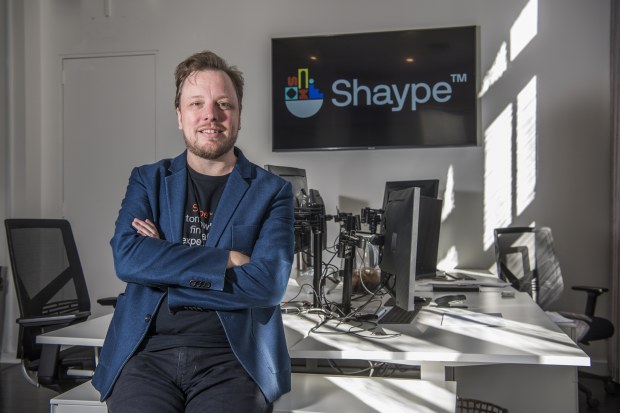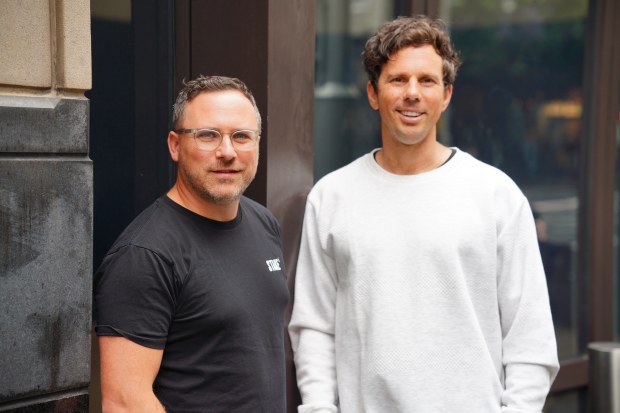Financial services elephants need the little guys
Global banking regulation has bolstered the case for bigger is better when it comes to financial services in the current age. But the bigger banks grow, the harder it is to innovate the types of solutions that deliver step-changes for customers.
Focused, agile fintechs are emerging thick and fast, helping the banking elephants to tie their shoelaces by solving parts of a puzzle that keeps growing as banks are forced to layer system upon legacy system and swim against the surging tide of regulation.

Andrew Laycock, founder and chief executive of Shaype. Steven Siewert
The winner of the financial services category in the AFR BOSS Most Innovative Companies awards, Shaype, encapsulates how fintechs are delivering for bank customers by working collaboratively alongside the big guys.
Shayping the future of banking
Shaype is best known for reshaping Commonwealth Bank of Australia’s Dollarmites accounts into Kit.
Since March this year, it has been deploying ShaypeWare as a layer that sits between core banking, legacy systems and the APIs that banks now plug in to help smooth delivery of services.
“ShaypeWare allows us to ingest data in any format. It can come from a 30-year-old core banking system that a bank has been running on for decades and transfer the information into a more modern format of data,” says founder and chief executive Andrew Laycock.
This eliminates the need for manual, time-consuming and costly intervention and allows banks to move much more quickly in responding to customer needs.
“We’ll give you all the missing ingredients as part of your recipe to bring a new service to market, and as a part of that we’ll give you this ShaypeWare layer,” says Laycock.
But given the huge regulatory push, Laycock says Shaype is focusing its efforts mostly on helping the big four banks keep up with their compliance burden.
This makes a lot of sense given more than half of current IT spend by banks is directed to keeping up with regulation.
Too much at Stake to leave to paper
Online investing platform Stake says customers shouldn’t have to fill out paper forms or send emails to move their portfolios between platforms. And it certainly shouldn’t take two weeks.
Stake chief executive Matt Leibowitz says there’s no reason why switching brokerage accounts shouldn’t be as seamless as changing banks, or rolling your superannuation across to a new provider.

Stake co-founders Dan Silver (left) and Matt Leibowitz.
“When we launched, a lot of our customers were existing brokerage customers at other places, whether that be large banks or a couple of independent players,” Leibowitz says. “Then we released Australian equities in early 2022 and there was a strong desire for customers to move all their brokerage accounts into the one spot. And the feedback we heard was that it was too difficult.”
Not content with the existing services in online broking, Stake set to work transforming the landscape to allow digital transfers.
“Ultimately, we worked internally, and we worked with partners externally to make it a reality and the first digital transfer tool in Australia. It’s pretty groundbreaking given that it took 25 years for online broking to get to this point,” says Leibowitz.
The online investing platform is biggest with Australians wanting to invest in United States equities. But with a $3 transaction fee and since launching Aussie equities in 2022, it is quickly becoming bigger for local investors too.
Since Stake set up the new transfer service, it has attracted more than $500 million in inflows and is now the third largest broker in Australia.
Investing the Islamic way
Hejaz Financial Services chief executive Hakan Ozyon isn’t shy about his ambition to capture Australia and then take on the world.
With 2 billion Muslims looking for more modern banking services than those offered by “old school” banks from the Middle East and some parts of Asia, Ozyon says it is only a matter of time before Hejaz goes global.
“The regulators don’t like me using this word, but we’re essentially a little monopoly. And that’s what’s great about this. Keep in mind the Muslim community in Australia is expected to be around 5 million by 2050,” says Ozyon.
“It’s a very, very large market. It is the fastest growing community in Australia and there’s only one institution.”
Ozyon says Hejaz is already the largest Islamic finance institution in Australia after releasing two new exchange traded funds (ETFs) on the ASX this year, one covering global REITs and another made up of global equities.
He plans to take the two new ETFs and list them on the London Stock Exchange, where Ozyon says the market is crying out for innovation and more modern investment products.
Hejaz is the only financial services company offering sharia compliant investments that also get the tick of approval from the Responsible Investing Australasia Association and the United Nations’ Principles for Responsible Investment organisation.
And he has no plans to stop at the Muslim market, saying there is no reason Hejaz cannot service the growing swell of people globally looking to allocate funds to socially responsible investments.
“That’s why we want to take this global because right now in the western economies around the world, all the Muslims in those countries are left without the sort of service and products that we can innovate. Hence why we see this as a great opportunity,” he says.
“I’ve actually contacted some of the five to seven banks in the UK that are run by Middle Eastern organisations and I’ve already told board members and the management teams they should shut down before I come there. I don’t think any of the systemic institutions that come from Asia or from Muslim countries in the Middle East and Asia understand the Western market the way we do.”
Helping those who help us
HESTA is demonstrating that even big companies can take tiny steps to innovate. General manager for experience Victor Marino says the superannuation giant was responding to its 80 per cent female membership base when it decided to launch an online tool to help people better connect with their money.
Marino says most members work in health and community services performing shift work. They’re not sitting in front of a computer during business hours and nearly a third are working multiple jobs. Financial literacy is below the Australian average, job security is worse and the risk of becoming injured is much higher.
“You can think about that worker as a kind of hero persona, but the challenge for us is how can we provide the best financial advice and how can we help them ensure that they have the best retirement outcomes in their lives, given all of those challenges,” says Marino.
HESTA wanted to design a financial advice program that would be understood, accessible and, most of all, deliver meaningful outcomes for members.
“At the core of the design is making sure we’re not building it for just anyone. It’s built for our membership base and helping them to get the best from their retirement and make the most of the little amount of money they’ll have,” says Marino.
The Australian Superannuation Funds Association says the amount needed to fund a comfortable lifestyle in retirement is between $595,000 for a single person and $695,000 for a couple, but Marino says only 31 to 32 per cent of HESTA members are retirement ready by the age of 67.
The tool was co-created with nearly 100 members from HESTA’s million strong pool and in the first 18 months, 200,000 members have signed on to use it. Marino says it helps HESTA break down the first, significant barrier to connecting people with super-embarrassment.
“Many of our members are ashamed of not knowing what to ask about their situation if they speak to someone directly. It’s just a simple way for them to take over control,” he says.
“One of the things we’ve learned from our members is it’s overwhelming just to think about super. You give up trying to understand it because it goes over our heads.”
Once online, HESTA members can quickly and easily learn about three core components of super: how small, additional contributions can compound to grow returns, how to decide your risk tolerance, and how to combine multiple accounts to avoid paying fees and build a bigger compounding sum.
Making it simple is working. Marino says the one in five members who have used the tool are significantly more confident about their future and that they are taking the right steps to being retirement ready.
“They know there are small things that they can do that will make a big difference,” he says.
Introducing your Newsfeed
Follow the topics, people and companies that matter to you.
Find out moreRead More
Latest In Financial services
Fetching latest articles